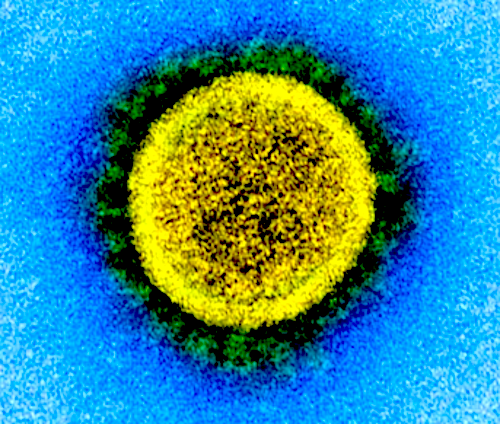|
|
Developmental Biology - COVID19
New Support of Remdesivir COVID-19 Treatment
Remdesivir, the investigational anti-viral drug, shows early promise in the fight against COVID-19...
Researchers at Vanderbilt University Medical Center (VUMC), the University of North Carolina at Chapel Hill and Gilead Sciences report that remdesivir potently inhibited SARS-CoV-2, the virus which causes COVID-19, in human lung cell cultures and improved lung function in mice infected with the virus.
These preclinical findings help explain the clinical effect the drug has had in treating COVID-19 patients. Remdesivir has been given to patients hospitalized with COVID-19 on a compassionate use basis since late January and through clinical trials since February.
On April 29, 2020, a preliminary report from the multicenter Adaptive COVID-19 Treatment Trial (which included VUMC) was published in Science Translational Medicine, suggesting that patients who received Remdesivir recovered more quickly.
"All of the results with remdesivir have been very encouraging, even more so than we would have hoped, but it is still investigational, so it was important to directly demonstrate its activity against SARS-CoV-2 in the lab and in an animal model of disease."
Andrea J. Pruijssers PhD, Department of Pediatrics, Vanderbilt University Medical Center, Nashville, Tennessee, USA.
Pruijssers, research assistant professor of Pediatrics at VUMC and lead antiviral scientist in the laboratory of Mark Denison MD, is the paper's co-corresponding author with Timothy Sheahan, PhD, assistant professor of Epidemiology at UNC-Chapel Hill.
These researchers were the first to perform detailed studies to demonstrate that the drug, developed by Gilead Sciences to combat hepatitis C and respiratory syncytial virus, and later the Ebola virus, has also shown broad and highly potent activity against coronaviruses in laboratory tests.
The latest findings, are reported this week in the journal Cell Reports, providing "the first rigorous demonstration of potent inhibition of SARS-CoV-2 in continuous and primary human lung cultures."
The study is also the first to suggest that remdesivir can block the virus in a mouse model.
Ongoing clinical trials will determine precisely how much it benefits patients in different stages of COVID-19 disease.
COVID-19, which to date has infected more then 12 million people and killed nearly 600,000 worldwide, is at least the third instance since 2003 in which a coronavirus originally transmitted from bats has caused serious illness in humans. Thus there is an urgent need to identify and evaluate broadly efficacious and robust therapies that can limit and prevent coronavirus infections. Adding: "Broad-spectrum antiviral drugs, antibodies, and vaccines are needed to combat the current pandemic and those that will emerge in the future."
Adding to SARS-CoV-2, studies in the Denison and Baric labs have shown remdesivir is effective against an array of coronaviruses, including bat viruses that could emerge in the future in humans.
"We hope that will never happen, but just as we were working to characterize remdesivir over the past six years to be ready for a virus like SARS-CoV-2, we are working and investing now to prepare for any coronavirus. We want remdesivir and other drugs to be useful both now and in the future."
Mark Denison MD, paper's co-corresponding author with Timothy Sheahan PhD, assistant professor of Epidemiology at UNC-Chapel Hill.
Abstract
Lysosomal enzymes are synthesized in the endoplasmic reticulum (ER) and transferred to the Golgi complex by interaction with the Batten disease protein CLN8 (ceroid lipofuscinosis, neuronal, 8). Here we investigated the relationship of this pathway with CLN6, an ER-associated protein of unknown function that is defective in a different Batten disease subtype. Experiments focused on protein interaction and trafficking identified CLN6 as an obligate component of a CLN6-CLN8 complex (herein referred to as EGRESS: ER-to-Golgi relaying of enzymes of the lysosomal system), which recruits lysosomal enzymes at the ER to promote their Golgi transfer. Mutagenesis experiments showed that the second luminal loop of CLN6 is required for the interaction of CLN6 with the enzymes but dispensable for interaction with CLN8. In vitro and in vivo studies showed that CLN6 deficiency results in inefficient ER export of lysosomal enzymes and diminished levels of the enzymes at the lysosome. Mice lacking both CLN6 and CLN8 did not display aggravated pathology compared with the single deficiencies, indicating that the EGRESS complex works as a functional unit. These results identify CLN6 and the EGRESS complex as key players in lysosome biogenesis and shed light on the molecular etiology of Batten disease caused by defects in CLN6.
Authors
Lakshya Bajaj, Jaiprakash Sharma, Alberto di Ronza, Pengcheng Zhang, Aiden Eblimit, Rituraj Pal, Dany Roman, John R. Collette, Clarissa Booth, Kevin T. Chang, Richard N. Sifers, Sung Y. Jung, Jill M. Weimer, Rui Chen, Randy W. Schekman and Marco Sardiello.
Acknowledgements
The study was supported by National Institutes of Health grants AI142759, AI132178 and AI132178-03S1, AI081197 and AI007151, the Dolly Parton COVID-19 Research Fund and the Elizabeth B. Lamb Center for Pediatric Research at Vanderbilt.
The authors have declared that no conflict of interest exists.
Return to top of page.
|
|
Jul 13 2020 Fetal Timeline Maternal Timeline News
 SARS-CoV-2 (shown here in an electron microscopy image). CREDIT National Institutes of Health.
|
|

